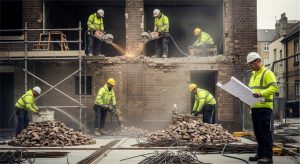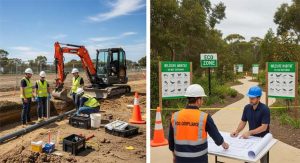
Preparing a construction site involves more than just trash removal and levelling.
Examining current structures, considering environmental and regulatory concerns, and creating a detailed implementation strategy are the phases. Something that should form the foundation for future growth might waste time and money if done wrong.
Site clearing is the most crucial step in building project planning, as it sets the tone for the entire project.
Site Preparation and Demolition Expertise

The process of site preparation is a speciality of many British businesses. A large number of individuals hire Cheshire demolition professionals to tear down buildings, address subsurface issues, and adhere to specifications for historical preservation. To facilitate the transformation of old construction sites into viable development zones, these professionals adhere to strict safety regulations.
Surveying and Planning for Clearance
A thorough site survey is the first step in every process. Before removal, engineers and experts carefully check out the area. These include asbestos, weeds, and decrepit structures, as well as garbage and waste. Create a detailed plan that suits the area after conducting a survey. Sometimes, planning involves ways to minimise the environmental impact, recycle materials that can be reused, and maintain traffic and public safety in areas with high population densities.
This level of planning makes sure that everything works properly during the clearance, from strip-outs to grading. It clears the terrain and makes it solid enough to support loads, utilities, and buildings. Additionally, this prevents problems that could prolong the project or increase its costs from arising. Contractors and specialists can collaborate effectively during the building process on a properly prepared, sustainable construction site. To finish work safely and legally, you need to prepare carefully.
Following the Rules for the Environment and the Law

Cleaning up a property requires strict environmental guidelines to protect the environment. UK brownfield regulations take into account wildlife habitats, contaminated soil, reducing carbon footprint, and water drainage systems. Brownfields are regulated. These regulations were implemented at an early stage. If these criteria are not adhered to, individuals may be subject to a fine or have their planning approval revoked. These events may occur simultaneously. There are no laws against clearing the area. To carry out mechanical work, specialists must first secure permission, then assess the risks involved, and finally devise effective waste management solutions.
Various circumstances may require you to collaborate with local authorities or other environmental organisations. Collaborating with clearance teams that are well-versed in the local area’s regulations makes things simpler. Teams that fail to handle these legal difficulties frequently encounter major delays in the project, which can impact the budget and have a negative influence on investor confidence.
Encouraging a Good Building Process
After legal and safe site clearance, construction managers, engineers, and architects can commence. Laying foundations doesn’t expose subsurface pipelines or trash. With appropriate planning, schedules can be safely organised. More importantly, stakeholders can now build legally and structurally. The first and most crucial step in project viability is site clearance. Thorough clearance sets the norm for responsible development.
![]()
Author Profile

- Eco Warrior by day, Eco Blogger by night trying to get the eco balance right.
Latest entries
 Green GuidesNovember 3, 2025The Beginner’s Guide to Making Your Own Nontoxic Candles at Home
Green GuidesNovember 3, 2025The Beginner’s Guide to Making Your Own Nontoxic Candles at Home Green Home GuidesOctober 14, 2025What are Eco-Friendly Tissue Options for Modern UK Homes?
Green Home GuidesOctober 14, 2025What are Eco-Friendly Tissue Options for Modern UK Homes? Best practicesSeptember 17, 20253 Ways Young Families Can Commit to Sustainable Living
Best practicesSeptember 17, 20253 Ways Young Families Can Commit to Sustainable Living EnvironmentSeptember 9, 2025Eco-friendly Gardening on a Budget: 6 Sustainable Choices that make a Difference
EnvironmentSeptember 9, 2025Eco-friendly Gardening on a Budget: 6 Sustainable Choices that make a Difference





Leave a Reply
You must be logged in to post a comment.